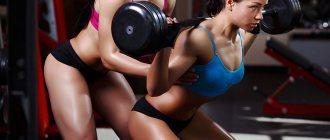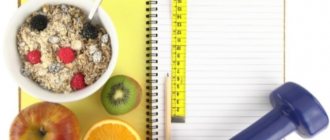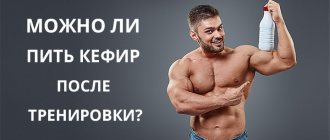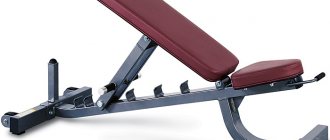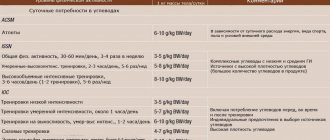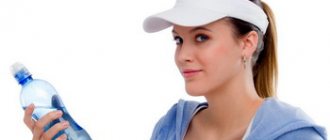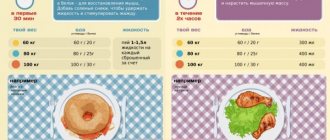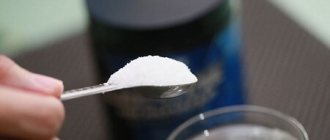Do your muscles hurt after strength training? This means you are not yet ready for the stress. Find out how to recover faster and progress as quickly as possible.
6 Tips for Faster Post-Workout Recovery
Whether you're trying to gain muscle, increase strength, or lose weight, you need to take care of yourself 24 hours a day. This is not an exaggeration. Of course, an hour or two of training is serious, but it only sets an incentive for growth. What you do the rest of the time will determine whether you can achieve your goals.
The recovery process that occurs outside the gym is primarily related to nutrition. It's probably your diet that has the greatest effect on your fitness. But the recovery process does not end there. There are a lot of subtleties and nuances.
What is the importance of muscle recovery after exercise?
During training, many biochemical processes occur. Muscle fibers are injured and glycogen is consumed. The response to stress most often manifests itself in pain after exercise. Of course, you can leave the gym and spend the rest of the day as if no training had ever happened. But the essence of proper recovery is to get the maximum benefit and reduce all the negative consequences of muscle microtrauma.
According to A. Barnett's 2006 study on recovery between workouts in advanced athletes, neglecting recovery will leave you unable to train properly and perform the required amount of work the next time you go to the gym. Fatigue can lead to injury. Moreover, full recovery is necessary to achieve optimal athletic performance.
Unfortunately, recovery is a purely individual matter.
Factors like age, genetics, training style and experience are extremely important. A 25-year-old professional bodybuilder and a 50-something rookie woman will recover differently. However, the following 6 tips will help almost anyone recover as efficiently as possible. Useful article: 15 techniques for effective training to gain muscle mass
What to choose - gainer or protein?
Protein is a substance that strengthens the body's protective functions and normalizes the nitrogen balance in the body. It contains a sufficient amount of amino acids to meet the body's needs. Protein supplements come in fast and slow forms. The first ones are suitable for those who want to quickly build muscle mass. The second ones are intended for athletes who are in the drying phase.
Gainers, unlike protein, consist of a mixture of various components, including proteins and carbohydrates. Both components are important for the training athlete. Protein helps build, and carbohydrate helps restore muscle tissue. In other words, one without the other does not have a complex effect and does not allow you to increase volumes. Therefore, bodybuilders should not limit themselves to just taking protein. They also need carbohydrates.
Gainers, as a rule, contain more carbohydrates than protein. There are expensive products that have an increased percentage of protein. An alternative and more affordable solution would be to purchase a high-carbon gainer that is mixed with a protein shake.
The main advantage of a gainer is that it allows you to quickly restore glycogen expended during training, as well as increase performance and improve recovery processes. The downside of the supplement is that it provokes an increase in body fat and is not suitable for people who tend to be overweight.
Abuse of gainers is not good for the athlete. If you drink the supplement in unlimited quantities, it can lead to an increase in subcutaneous fat. In other words, mass gainers are suitable for people with a naturally thin build or a high metabolism. The rest either need to purchase an expensive high-protein supplement or mix protein shakes and gainers together.
The gainer must contain complex carbohydrates. It is best taken one hour before training and 20 minutes after completing the activity. Beginning athletes who quickly gain excess weight should limit themselves to protein in the initial stages of training. Beginners who lack mass are recommended to give preference to gainers.
Which is better PROTEIN or GAINER?
Consume BCAAs and carbohydrates during exercise
Drinking plain water between sets is essential for proper hydration and body temperature regulation. But adding carbohydrates or amino acids to your water will also improve your energy and well-being.
“Carbohydrates are the main source of energy for your muscles,” says nutritionist Paul Salter. – The harder and more intense you train, the more fuel your body requires in the form of carbohydrates. This is especially true for sports like powerlifting and bodybuilding, where short periods of time under tension are expected.”
But getting energy during exercise is just the beginning. “Carbohydrates have an anti-catabolic function. They minimize muscle breakdown,” Salter writes. – If consumed during training, they will reduce overall muscle damage from exertion. They have a positive effect on recovery time because fewer muscle cells are injured.”
To get maximum benefits, consume the “right” carbohydrates. Fast carbohydrates like glucose, dextrose or carbohydrate sports nutrition products are suitable for us. It is also important to consider the duration of the workout and the amount of carbohydrates consumed so as not to overload the gastrointestinal tract.
Carbohydrate intake during exercise
| Duration of training | Amount of carbohydrates | Amount of water |
| Less than 45 minutes | 0 grams | 500–750 ml |
| 45–60 minutes | 15–30 grams | 500–750 ml |
| 60–90 minutes | 30–50 grams | 750 ml |
| Over 90 minutes | 50–75 grams | 1 l |
Carbohydrates are great on their own, but when paired with branched chain amino acids (leucine, isoleucine, and valine), they become even better. Carbohydrates and BCAAs are designed to reduce muscle breakdown and cortisol levels, which is not the case with plain water. In addition, taking them before or during exercise will reduce post-workout pain.
Massage roller after workout
Massage is wonderful. But often there is not enough money or time for it, and not many studies have confirmed its benefits for recovery. This does not mean that you should refuse a massage if you like it. For example, R. M. Tiidus in his work “Alternative treatment of muscle microtraumas” recommends massage after training. You can simply resort to a more affordable option, for example, self-massage using a roller.
Over the past few years, research has been conducted on the benefits of myofascial release. A 2015 Canadian study (“Rolling for muscle fatigue and recovery from dynamic exercise”) found that using a foam roller reduced post-workout soreness. The subjects performed self-massage on a roller immediately after training, 24 and 48 hours later.
Someone might think that a massage roller can be replaced with a regular stretch. But that's not true. The 2011 study by R.D. Herbert and M. de Norona, “Stretching as a Way to Prevent Muscle Soreness after Exercise,” found that stretching was ineffective in promoting recovery.
If after training you don’t have the energy and time to massage with a roller, try this: use the roller after each approach in the last exercise. You will get all the benefits without stretching your time in the gym.
Consequences of Covid
Doctors working in infectious diseases hospitals claim that not one of those who have had a severe form of coronavirus leaves the hospital as an absolutely healthy person. This disease does not go away without consequences, and a feeling of slight malaise can persist for many weeks and even months.
The discomfort and complications that arise after coronavirus are called post-Covid syndrome.
Medicine has not yet studied all the long-term consequences of coronavirus infection COVID-19. Doctors name several of the most common consequences that require high-quality rehabilitation:
- insomnia or excessive sleepiness;
- constant weakness, fatigue;
- decreased performance;
- memory impairment, cognitive impairment (difficulty concentrating);
- asthenic syndrome (even habitual physical activity becomes unbearable);
- blood pressure disorders (hypertension or hypotension);
- arrhythmia, tachycardia, bradycardia;
- dyspnea;
- respiratory dysfunction;
- dyspepsia, deterioration of the gastrointestinal tract;
- decreased vision after conjunctivitis;
- depression.
If the disease is severe, the consequences can be very serious:
- pulmonary fibrosis;
- heart attack;
- stroke;
- thrombosis;
- gangrene.
After severe Covid, a person has the risk of remaining disabled. Most often this occurs due to extensive lung damage or gangrene that develops as a result of thrombosis. After the patient is assigned a disability group, he will receive an individual rehabilitation program.
Treatment procedures for recovery from coronavirus should begin immediately after completion of the 14-day quarantine. When the patient can leave home again and communicate with others, rehabilitation needs to begin.
Infrared sauna for recovery
Muscle recovery is faster in an infrared sauna.
Infrared saunas increase body temperature. In one study, subjects experienced reduced post-exercise muscle soreness by regularly going to the sauna. The infrared sauna is a favorite method for relieving tension among American football players.
“Infrared saunas relax tired muscles and joints, which is necessary for people involved in strength sports,” say researchers F. Oosterveld and B. Westhuis in the scientific article “Infrared saunas and health; physiological effects of hyperthermia." “Because infrared saunas increase body temperature, heart rate, blood pressure and sweating, you need to be adequately hydrated.”
Do not confuse infrared therapy with a regular sauna, steam bath or jacuzzi. After a good workout, your body temperature is already elevated. Saunaing after exercise will lead to dehydration, cramping, and in some cases, hyperthermia. For this reason, infrared saunas are not recommended immediately after exercise.
An infrared sauna is available in many spas. If you're actively training and preparing for a competition, an infrared sauna is a good way to reward yourself for your efforts in the gym.
Methods for muscle recovery
- Restoration of breathing and pulse. The very first method on the path to muscle recovery. At the finish line, you should not stop abruptly; you should slow down the pace gradually, take deep breaths, reducing their frequency. Placing your hands on your belt or on your hips will allow you to open your lungs more fully.
- Running pace. Muscle recovery is directly related to running speed. You can't just run fast. The pace increases gradually, starting with a calm run.
- Water. It is very important to replenish the water deficit in the body caused by jogging. You need to drink in small portions, but often. It is recommended to quench your thirst only with still water. During the entire recovery cycle, you should train yourself to drink a lot of clean water.
- Shower or pool. Taking a shower after a run should not only be for hygiene reasons. Cool water or alternating it with cold water helps relieve muscle tone, activates blood circulation and energizes you.
- Warm bath or sauna. Taking a warm bath with aromatic oils or a short visit to the sauna helps relax the muscles throughout the body.
- Nutrition. Immediately after training, you need to eat a banana or a serving of protein supplement. During the period of muscle recovery, the need for proteins and carbohydrates should be met at the rate of 2 g of pure protein for every kilogram of your weight. Nutrition must be correct and balanced: the diet should always contain solid protein foods and raw vegetables.
- Warm up. Before jogging, you need to warm up your ankle joints and do a few leg swings. After running, your legs need five minutes of thorough stretching.
- Massage. A good method aimed at accelerating the blood and relieving fatigue of the calf and other muscles. An equally effective method, along with massage, is to use the Kuznetsov applicator. Before training, a massage session is recommended to warm up the working muscles.
- Rest. For an hour after jogging, it is useful to lie down in a dimly lit room with a cushion under your feet. This helps blood circulation and relieves the feeling of heavy legs.
- Dream. Full muscle recovery is impossible without productive sleep. You need to sleep at least 8 hours continuously. A good habit would be to take a walk in the fresh air every night before going to bed.
- Ointments or other medications. In some cases, you simply cannot do without special pharmacological drugs that accelerate muscle recovery. Their use must be carried out with the permission of a doctor.
Consume More Protein Post-Workout
Most people add about 20 grams of protein powder to their carbs in their post-workout shake. But scientists advise doubling this amount for better protein synthesis and recovery (L. S. McNaughton, “Response of Muscle Protein Synthesis After Fatigue of All Muscle Groups to 40 and 20 Grams of Whey Protein”).
Research has shown that protein synthesis increased by 20% in those who consumed 40 grams of protein. In addition, the improvement in protein synthesis did not even depend on the percentage of body fat in the test subject.
Increase your sleep time

Lack of sleep is a nightmare for your form. Brazilian scientists M. Dattilo and J. Antunes have proven that lack of sleep and poor quality of sleep can increase weight (“Sleep and muscle recovery: endocrinological and molecular basis for a new hypothesis,” 2011). This happens mainly due to increased hunger and appetite. Poor sleep also impairs muscle recovery and protein synthesis by increasing catabolic hormones and decreasing anabolic hormones such as testosterone and insulin-like growth factor.
It is important not only the amount of night sleep (7-9 hours), but also its quality. To get the most out of your sleep, follow these tips:
- Keep the room temperature cool. Rooms without air conditioning that are located on the sunny side will heat up more in the summer and take longer to cool down. Use fans and cover windows.
- Use blackout curtains, especially in summer when the sun rises early in the morning.
- If noise outside the window or from neighbors prevents you from falling asleep, turn on a recording of nature sounds - they will help you relax.
- Don't forget about the phenomenon of sleep apnea syndrome (sudden cessation of breathing during sleep). This is a common occurrence among bodybuilders and athletes involved in strength sports.
Which doctors deal with rehabilitation after Covid?
A patient who has recovered from Covid should see a general practitioner and physiotherapist. The first doctor will prescribe the necessary medications and monitor the dynamics of the patient’s condition during recovery. The second doctor will prescribe physiotherapeutic procedures according to an individual program.
The most common physiotherapy procedures used after coronavirus:
- inhalation;
- SMT therapy;
- ultrasound therapy;
- infrared laser treatment;
- ILBI;
- chest massage;
- magnetotherapy.
During restorative procedures, the patient will require consultations with several doctors of narrow specialties:
- neurologist;
- pulmonologist;
- cardiologist;
- endocrinologist;
- ophthalmologist
The doctor can refer the patient for additional diagnostic procedures that will allow him to monitor the patient’s well-being over time. Such procedures include:
- pulse oximetry;
- X-ray of the lungs in two projections;
- ECG;
- study of heart function using the Holter method;
- spirography;
- 24-hour blood pressure monitoring;
- Echo-CG;
- Ultrasound of leg vessels;
- MRI of the brain;
- coagulogram;
- general clinical blood test.
A biochemical blood test is required for a number of indicators:
- C-reactive protein.
- IgE.
- D-dimer.
- Antistreptolysin O.
- Eosinophilic cationic protein.
Diagnostic studies are carried out at the beginning of the recovery process and after the end of the rehabilitation course. If the patient’s well-being does not improve or progress is too slow, the procedures continue.
Do light cardio for a healthy heart
This is great advice that many people neglect. After your main workout, you should do some gentle cardio. Its length may vary. At the end of the workout, the heart rate (hereinafter referred to as HR) should not exceed the norm by more than 10–20 beats. The study showed that such aerobic exercise will help remove metabolic waste products (lactate, ammonium and hydrogen ions) that arise after anaerobic exercise. As a result, you will recover much faster for the next workout, say T. Bompa and S. Bucicelli in their work “Periodization of the training process in sports.”
First you need to find out your normal heart rate. You can measure it every day in the morning for several days, and then calculate the arithmetic average.
When you have finished your workout, measure your blood pressure and heart rate. Do 2 minutes of low-intensity cardio for every 10 beats above your normal heart rate. It is recommended to use an elliptical if you have done upper training before, and an exercise bike if you have done leg training before. If you did cardio before, use any exercise machine you like.
So, if your post-workout heart rate is 135 beats per minute, and your normal is 65, then the difference between them is 70. This means that you need to do cardio for 14 minutes.
After all this, we go to the shower and begin to actively recover. After some time, we return to the hall and repeat again and again.
How long will it take to recover from Covid?
If a person has had a mild or moderate form of coronavirus, recovery will take about 1 month. After a severe form of the disease (especially with complications), the patient will have to recover for 6 months or even longer (up to 1 year). Covid often leads to disability.
Since the disease has not yet been sufficiently studied, doctors have not yet fully figured out the effect of the COVID-19 virus on humans. Therefore, medicine cannot yet give accurate forecasts and set exact periods during which the body can recover.


